Real Estate Virtual Staging Software: Elevate Listings
Discover real estate virtual staging software that transforms listings, boosts appeal, and speeds sales. Learn how it works and how to choose a platform.
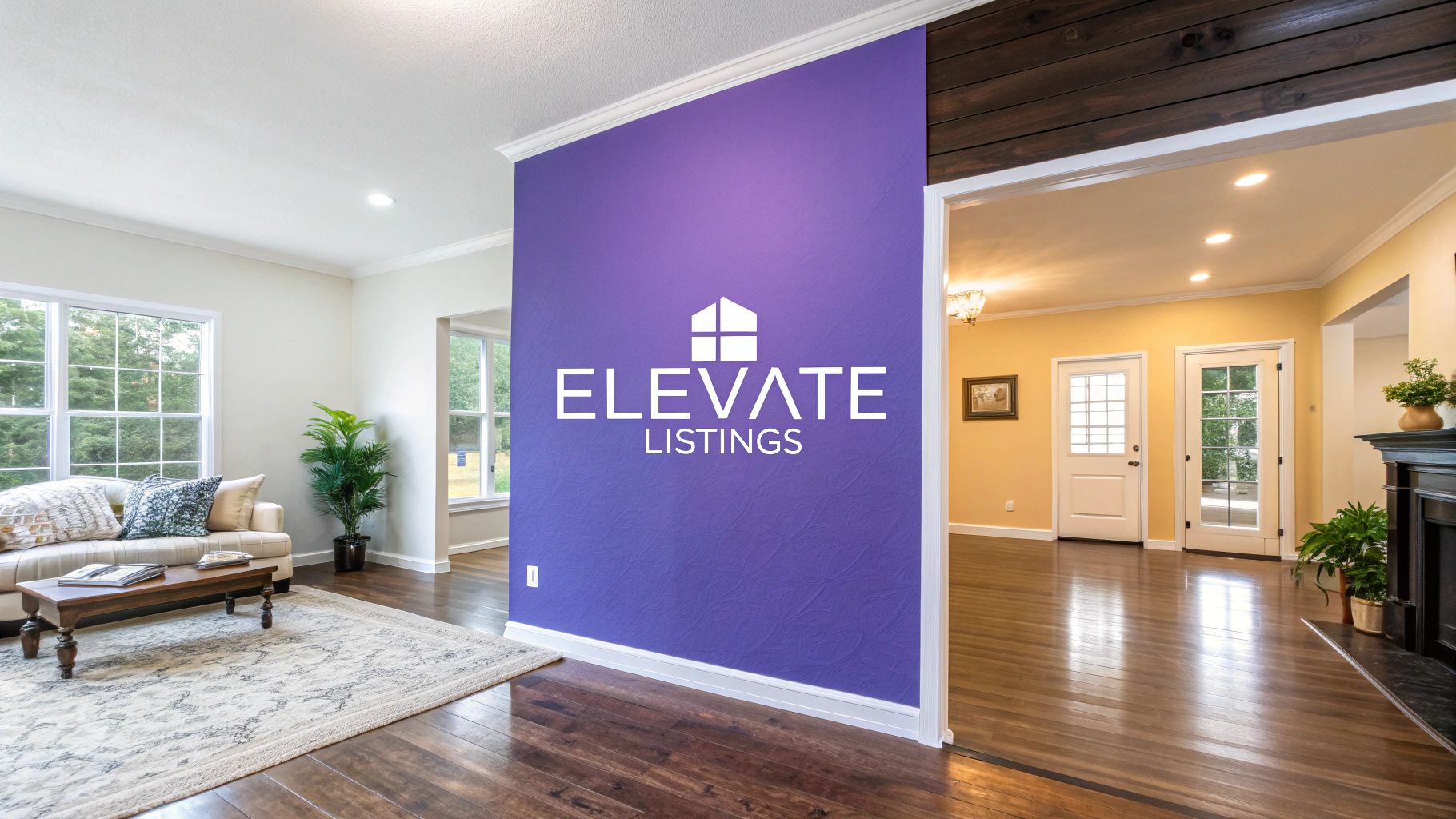
Ever tried to sell a beautiful house that’s completely empty? It’s tough. Most buyers walk into a vacant property and just can't picture themselves living there. That empty space creates an 'imagination gap' that can kill a potential sale before it even starts. This is exactly where real estate virtual staging software comes in. It's the tool that turns those empty, uninspired photos into warm, inviting homes that buyers can connect with instantly.
Sell the Vision, Not Just the Space
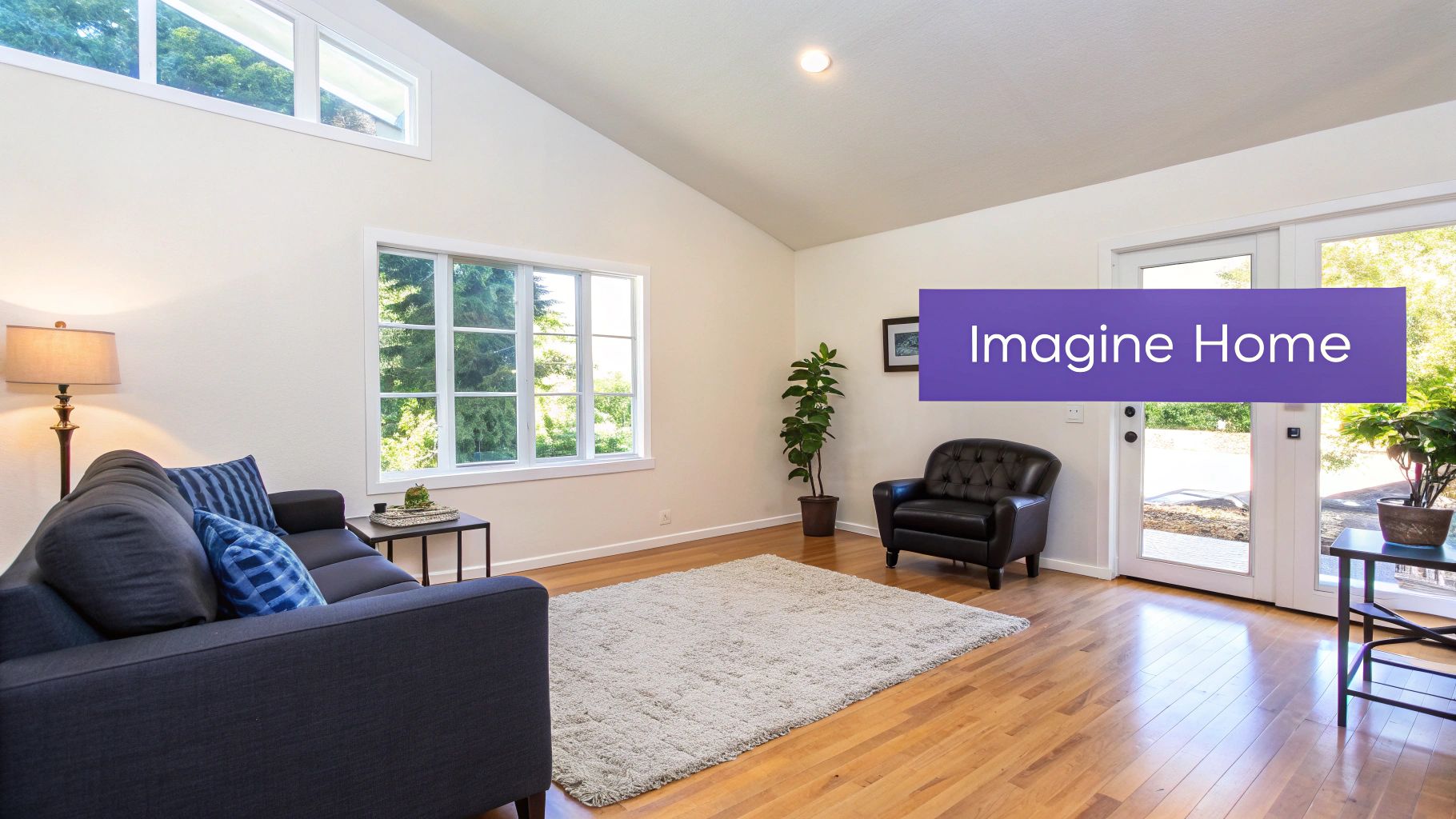
Let's face it, an empty room is just a box of walls, floors, and windows. It lacks any feeling or context, leaving buyers cold. They can't tell how big the room really is or figure out if their own couch would even fit. This is a huge roadblock because buying a home is deeply emotional. If a buyer can’t form a connection, they’ll just click to the next listing.
Virtual staging was built to fix this very problem. By digitally placing stylish furniture, rugs, art, and decor into photos of empty rooms, you create a powerful story. All of a sudden, that blank slate becomes a cozy living room ready for movie night, or a peaceful bedroom sanctuary.
From Empty Space to Dream Home
The best software doesn't just plop furniture into a room; it helps you tell a story that resonates with your ideal buyer. You can create a sleek, minimalist vibe with a Japandi inspiration to attract young professionals or go for a warm, modern farmhouse style to appeal to a growing family. This kind of flexibility lets you target different buyers without the massive cost and hassle of physical staging.
Virtual staging has moved beyond just adding furniture. It’s about crafting a tangible lifestyle vision that helps buyers feel an immediate emotional connection to a property.
That emotional connection is what gets people to act. It leads to more clicks, more time spent looking at your listing, and most importantly, more requests for in-person tours. For more ideas on using visuals to capture leads, these video lead generation strategies offer some great complementary tactics.
The Power of Hyper-Realistic Visualization
Today's platforms are pushing the boundaries of realism. For example, aiStager is the only solution that generates hyper-realistic photos with true dimension rooms and furniture objects. This is a huge leap past the generic 3D models you might be used to.
Imagine being able to show a client how a specific sofa from Restoration Hardware would look compared to a sectional from West Elm, all in different colors and fabrics. With aiStager, you can just upload a photo of the room and a link to a product, and the software places a perfectly scaled item in the space in a few clicks. This incredible detail ensures what buyers see online is a true representation of the home's potential, closing that imagination gap and turning casual online lookers into serious, interested buyers.
So, How Does Virtual Staging Actually Work?
Imagine you have an expert interior designer on speed dial, ready to style any room in minutes. That’s essentially what virtual staging software does. You skip the hassle and high cost of renting furniture, hiring movers, and paying a traditional stager. Instead, you just upload a good-quality photo of an empty space.
From there, the magic begins. You can digitally place everything from a cozy sectional sofa to the perfect piece of wall art, turning a blank, uninspiring room into a home that buyers can truly envision themselves in.
From a Simple Photo to a Stunning Reality
While the process feels simple on your end, there's some seriously smart technology working behind the scenes. Early versions of real estate virtual staging software were a bit clunky and sometimes looked obviously fake. But today's AI-driven platforms are a whole different story, creating images so realistic they're often impossible to tell apart from a traditionally staged photo.
Here's a peek at how it all comes together:
- Reading the Room: The software first analyzes the photo to understand the space—it measures the dimensions, figures out the perspective, and maps the overall layout.
- Understanding the Light: It then identifies where the light is coming from, mapping out the natural shadows and even the color temperature to ensure every added object looks like it truly belongs.
- Finding the Right Style: You get to be the designer, choosing from popular styles that resonate with US consumers, like a warm Modern Farmhouse vibe or a clean Mid-Century Modern look.
This deep analysis is what allows the software to add furniture that doesn't just look great, but also fits perfectly into the room’s specific lighting and dimensions.
Why “True-to-Scale” Is a Game-Changer
What really separates the good from the great in virtual staging is getting the scale just right. After all, a chair that looks too big or a rug that looks too small can completely throw off a buyer's perception of the space.
This is where a tool like aiStager stands out, as it’s the only solution that generates hyper-realistic photos with true dimension rooms and furniture objects. This is a massive leap from older tools that rely on generic 3D models which often make a room feel distorted or misleading.
Think about it this way: with aiStager, you can test out specific, real-world products. You could drop a West Elm 'Harmony' sofa into the living room to check its fit, then instantly swap it for a larger Crate & Barrel sectional. You can even play with different colors and fabrics to see what complements the room best.
This technology is more than just digital decorating; it’s a powerful visualization tool. In just a few clicks, users can place a new product in their room just by uploading a photo of the room and a link to a product, making design experimentation effortless and accurate.
Giving buyers the ability to see real, branded furniture scaled perfectly in a room helps them connect on a much deeper level. It builds trust and makes the space feel tangible. This is one of the most exciting developments we're seeing with the rise of virtual staging with AI.
The market is clearly taking notice. The global virtual staging software market was valued at $230 million in 2023 and is expected to rocket to around $1.2 billion by 2030. This growth is fueled by a real estate industry that’s embracing digital tools to capture the attention of online home shoppers. You can learn more about the growth of the virtual staging market and what’s ahead.
Ultimately, this technology closes the gap between seeing an empty house and imagining a future home.
The Business Case for Virtual Staging
Let's get straight to the point: choosing virtual staging isn't just a creative flourish—it’s a smart business move that directly boosts your bottom line. Think about traditional physical staging for a moment. It's a logistical headache and a serious investment, often running into thousands of dollars for furniture rentals, movers, and designer fees. The whole process can eat up weeks, delaying your listing from hitting the market.
Now, consider the alternative. Real estate virtual staging software delivers incredible, versatile results for a tiny fraction of the cost, and it does so in hours, not weeks. This speed is a game-changer. You can get properties listed faster, grab immediate buyer attention, and start generating leads while your competition is still coordinating furniture deliveries. The money you save is obvious, but the strategic edge you gain is even more valuable.
This infographic lays out the massive growth and financial scale of the virtual staging market. It’s not a niche tool anymore; it’s a core part of modern real estate.
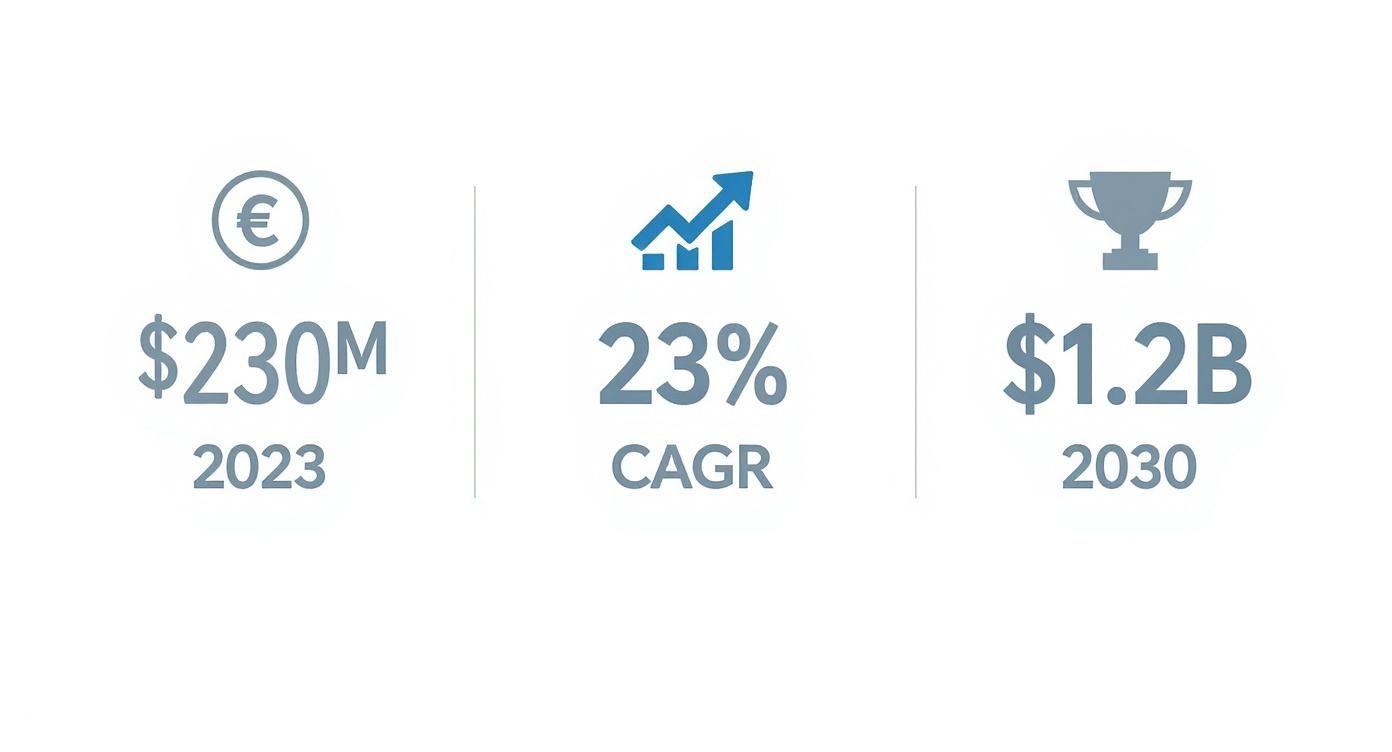
The numbers tell a clear story. Virtual staging is a rapidly expanding industry, proving its growing importance and impressive return on investment for agents and brokers.
Virtual Staging vs Physical Staging: A Cost and Time Comparison
To really see the difference, let’s break down how virtual and physical staging stack up side-by-side. The contrast in cost, time, and flexibility is stark.
| Factor | Virtual Staging | Physical Staging |
|---|---|---|
| Cost | Typically $20-$100 per photo. | Often $2,000-$10,000+ per project (monthly fees). |
| Time | Turnaround in 24-48 hours. | Can take 1-3 weeks for coordination and setup. |
| Flexibility | Unlimited revisions and style changes with a few clicks. | Changes are expensive, slow, and labor-intensive. |
| Logistics | Zero physical coordination required. | Involves movers, furniture rental, and scheduling. |
This table makes it clear why so many real estate professionals are making the switch. The efficiency and cost savings of virtual staging are simply too significant to ignore.
Tailoring Listings to Every Buyer Persona
Here’s where virtual staging truly shines: you can customize a single listing for completely different types of buyers. Imagine you have a two-bedroom condo in a bustling downtown area. With a few clicks, you can show it off in multiple ways:
- For the Young Professional: Stage it with a sleek, minimalist vibe, complete with a dedicated home office and modern furniture from a brand like Article.
- For a Small Family: Instantly re-stage that second bedroom as a nursery or a fun playroom, and fill the living room with a cozy, inviting sectional sofa.
- For the Empty Nester: Style the space with sophisticated, elegant decor, highlighting its potential as a low-maintenance, upscale city pad.
Trying to achieve this with physical staging would be absurdly expensive and time-consuming. With virtual staging, you can craft different visual stories for the same property, making sure your marketing connects with the widest possible audience.
The Power of Hyper-Personalization with aiStager
Modern tools like aiStager push this flexibility to a whole new level. It's the only solution that generates hyper-realistic photos with true dimension rooms and furniture objects, which means it goes way beyond generic digital furniture. You can instantly drop in real-world products to see exactly how they look and fit.
For instance, you could stage a living room with a specific sofa from Pottery Barn, then, with a simple click, swap it for a different Crate & Barrel model in various colors. All you need to do is upload a photo of the room and provide a link to the product you want to see. This turns a static listing into an interactive design experience, allowing you to answer a client's classic question—"Will my furniture fit?"—with a beautiful, accurate visual.
In today’s market, a staggering 51% of homebuyers find their new home online first. This makes a killer first impression absolutely essential to get them in the door.
Driving Real-World Business Outcomes
At the end of the day, the business case for virtual staging is proven by the results. Professionally staged photos don't just look pretty; they perform better. They command more attention on sites like Zillow, keep potential buyers on your website longer, and build the emotional connection needed to schedule a showing. Study after study shows this visual appeal directly speeds up sales, leading to more offers and a higher final sale price.
This modern approach to visual marketing is a cornerstone of building a thriving real estate business. For a deeper dive into scaling your operations, check out our guide on the business of interior design.
Of course, while amazing property visuals are key, your personal brand also plays a huge role in building trust. To round out your marketing, it's worth exploring what makes for effective professional real estate headshots. When you combine stunning property images with a polished professional image, you create a powerful strategy that delivers real, measurable growth.
Must-Have Features in Staging Software
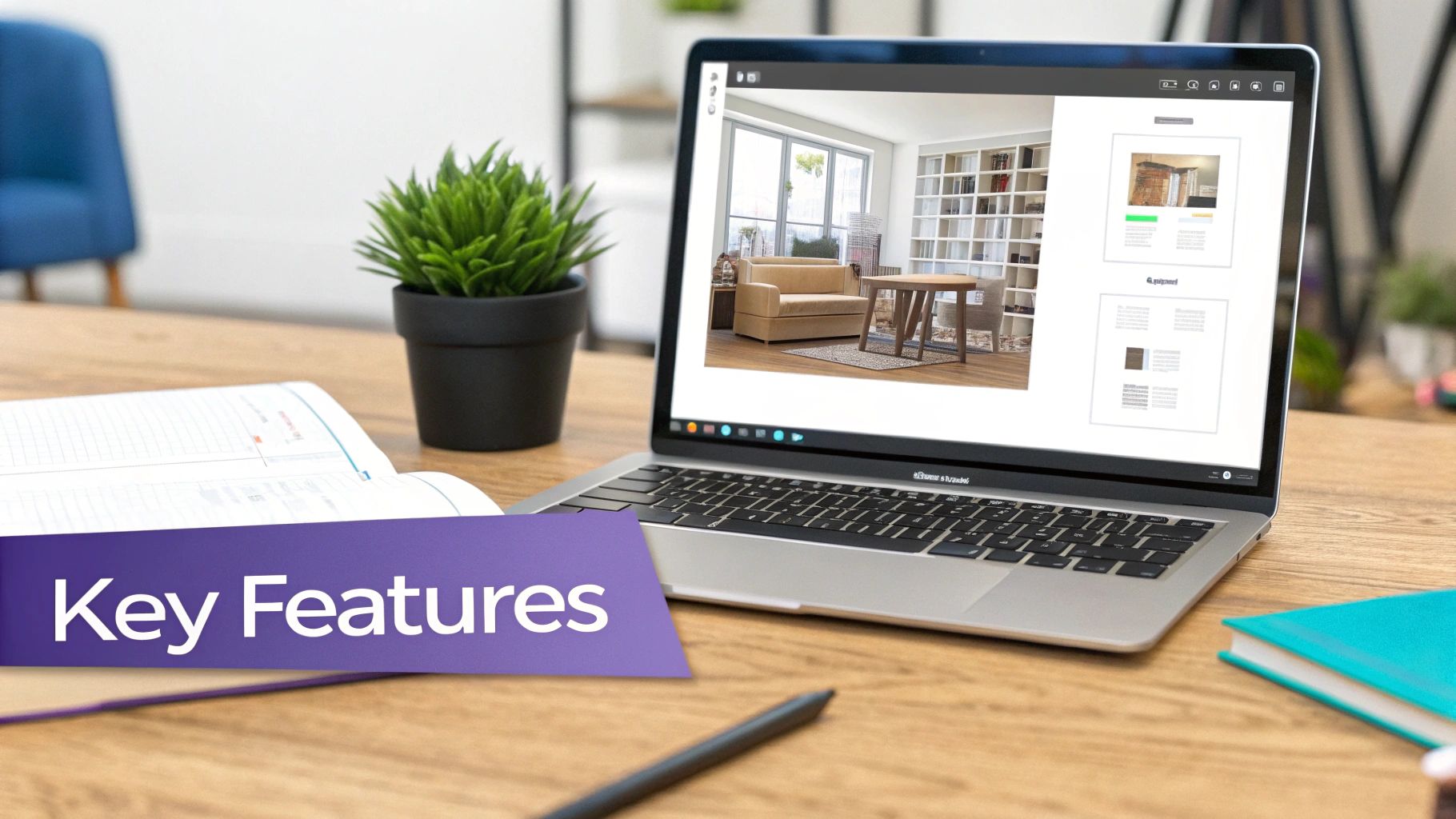
Let's be honest, not all virtual staging software is created equal. While most tools can drop a digital sofa into an empty room, the real magic happens in the details. The difference between a decent tool and a great one comes down to realism, flexibility, and how easy it is to use. To get a true edge, you need to look past the basic features.
A great place to start is the digital furniture library. Some platforms give you a handful of generic, cookie-cutter items, but the best ones offer a massive, carefully curated collection of furniture and decor. This is what lets you style a home to match a specific buyer’s dream, whether that’s a breezy coastal living room or a sharp, minimalist office.
The market for these tools is exploding—valued at $0.35 billion in 2024, it's on track to hit nearly $5.98 billion by 2033. This incredible growth is pushing software developers to deliver more powerful and realistic features every day. You can get a closer look at this expanding market and its drivers.
Beyond a Static Furniture Library
The most exciting leap forward in staging software is the ability to break free from a pre-set furniture catalog. This is where the truly advanced platforms pull away from the pack. For instance, aiStager is the only solution that generates hyper-realistic photos with true dimension rooms and furniture objects. This isn't just about decorating a room; it’s about turning the process into a dynamic and incredibly accurate design tool.
Imagine you're staging a master bedroom and want to prove to buyers it can easily fit a king-sized bed. Instead of using a generic 3D model, you could drop in a specific bed frame from Pottery Barn. All it takes is a photo of the room and a link to the product. The software then generates a true-to-scale, dimensionally accurate model right in your photo, almost instantly.
This is a huge advantage. You’re answering a buyer’s questions before they even think to ask, showing them exactly how their own furniture could fit and helping them form a much deeper connection to the property.
The ability to use real, branded products in a virtual stage is a game-changer. It elevates a listing from a simple showcase to an interactive design experience, offering unmatched realism and customization.
Dynamic Design and Sales Capabilities
This technology also gives you incredible creative freedom. You’re no longer stuck with just one look. You can try out different design styles to see what clicks with different buyers.
- Modern Farmhouse: Try out a rustic dining table paired with sleek, modern chairs.
- Bohemian Chic: Experiment with layered rugs and a unique accent chair from Article.
- Mid-Century Modern: Compare a few different sofa styles from a brand like Room & Board, testing various fabrics and colors.
This level of detail is what sells homes. The power to test three different sofas—complete with different colors and finishes—in a matter of minutes helps you craft the perfect story for every listing. You can even create multiple versions of a room for targeted marketing campaigns, speaking directly to different buyers’ tastes. Your staging software becomes less of a simple tool and more of a powerful sales engine. To really round out the presentation, many agents also include a rendered floor plan to give buyers a complete view of the home's layout.
Hyper-Realistic Rendering Quality
At the end of the day, the quality of the final image is everything. The best software creates photorealistic images where the lighting, shadows, and textures look so real you can’t tell them apart from an actual photograph. AI-powered platforms are particularly good at this, as they can analyze the natural light in the original photo and make sure every digital object casts a perfect shadow and reflects light just as it would in real life.
This is what makes virtual staging work so well. When a buyer can’t tell the furniture is digital, it’s easier for them to imagine themselves living there. That emotional connection is what leads to more showings, quicker offers, and better sale prices. When you're picking a tool, make sure rendering quality is your top priority.
Choosing the Right Virtual Staging Partner
Picking the right real estate virtual staging software is a huge decision. It’s going to directly affect your workflow, how well your marketing lands, and, of course, your budget. With more and more options popping up, each with its own mix of features and price tags, you need to do your homework to find a true partner for your business.
This isn't just about finding the cheapest option. It’s about investing in a platform that actually fits what you do, whether you're juggling a ton of listings or just need to spruce up a few here and there. The right partner saves you time and money; the wrong one just gives you headaches, delays, and results that don't impress anyone.
Evaluating Key Platform Features
When you start comparing different tools, the first thing to look at is the quality. How real does it look? The whole point is to make a buyer forget they're even looking at a digitally furnished space. Always ask for a demo and get really picky about the details.
A huge differentiator is whether a platform can go beyond a generic, pre-loaded furniture catalog. This is where a tool like aiStager really changes the game, as it's the only solution that generates hyper-realistic photos with true dimension rooms and furniture objects. This is a massive leap forward.
Instead of being stuck with a library of stock items, you can show clients exactly how a real-world product, like a cool sofa from Joybird, would look in their future living room. You can even play around with different colors and finishes to match specific vibes, from a cozy Modern Farmhouse look to a minimalist Japandi aesthetic, which can help you connect with different types of buyers.
The most powerful virtual staging tools offer more than just decoration; they provide a dynamic design experience. With aiStager, users can place a new product in their room in just a few clicks, just by uploading a photo of the room and a link to a product.
This kind of feature is priceless for answering those inevitable client questions about space and scale before they even set foot inside the property.
Comparing Pricing Models and Support
Virtual staging services usually offer a few different ways to pay, and the best one for you really boils down to how many properties you handle.
- Per-Photo Fees: This is the classic model where you pay a flat rate for each staged image. It’s perfect if you only need virtual staging every now and then.
- Subscription Plans: If you're part of a busy brokerage or an agent with a high volume of listings, a monthly or annual subscription can be much more cost-effective. These plans often come with a set number of credits or even unlimited staging.
- Credit-Based Systems: Some platforms use a credit system. You buy a bundle of credits upfront and use them for different services as you need them, which offers a lot of flexibility.
Beyond the price tag, you have to think about turnaround time. In real estate, speed is everything. Can the service get you high-quality images back within 24-48 hours? Just as important is their customer support. If you hit a snag or need a change, is there a responsive team you can actually talk to? Good support is a tell-tale sign of a reliable partner.
Questions to Ask During a Demo
When you sit down for a demo, don't just let them run through their sales pitch. Come prepared with a list of questions to dig a little deeper and see if the platform is really a good fit.
- How realistic are the shadows and lighting? Ask to see before-and-after shots of rooms with tricky lighting.
- How diverse is the design library? Can you create different styles, from Industrial Loft to Coastal Grandmother, to attract a wider pool of buyers?
- Can I test specific products from real brands? This is a big one. For example, can you actually drop in different sofa brands to see which one fits the space best?
- How intuitive is the user interface? Is this something your whole team can pick up and use without needing weeks of training?
- What is the process for revisions? If the first draft isn't quite right, how quick and easy is it to get changes made?
Choosing your virtual staging partner is an investment in your brand and your listings. By thinking through these factors, you can find a real estate virtual staging software that doesn't just create beautiful images but becomes a smooth and powerful part of your marketing strategy.
Best Practices for Stunning Virtual Results
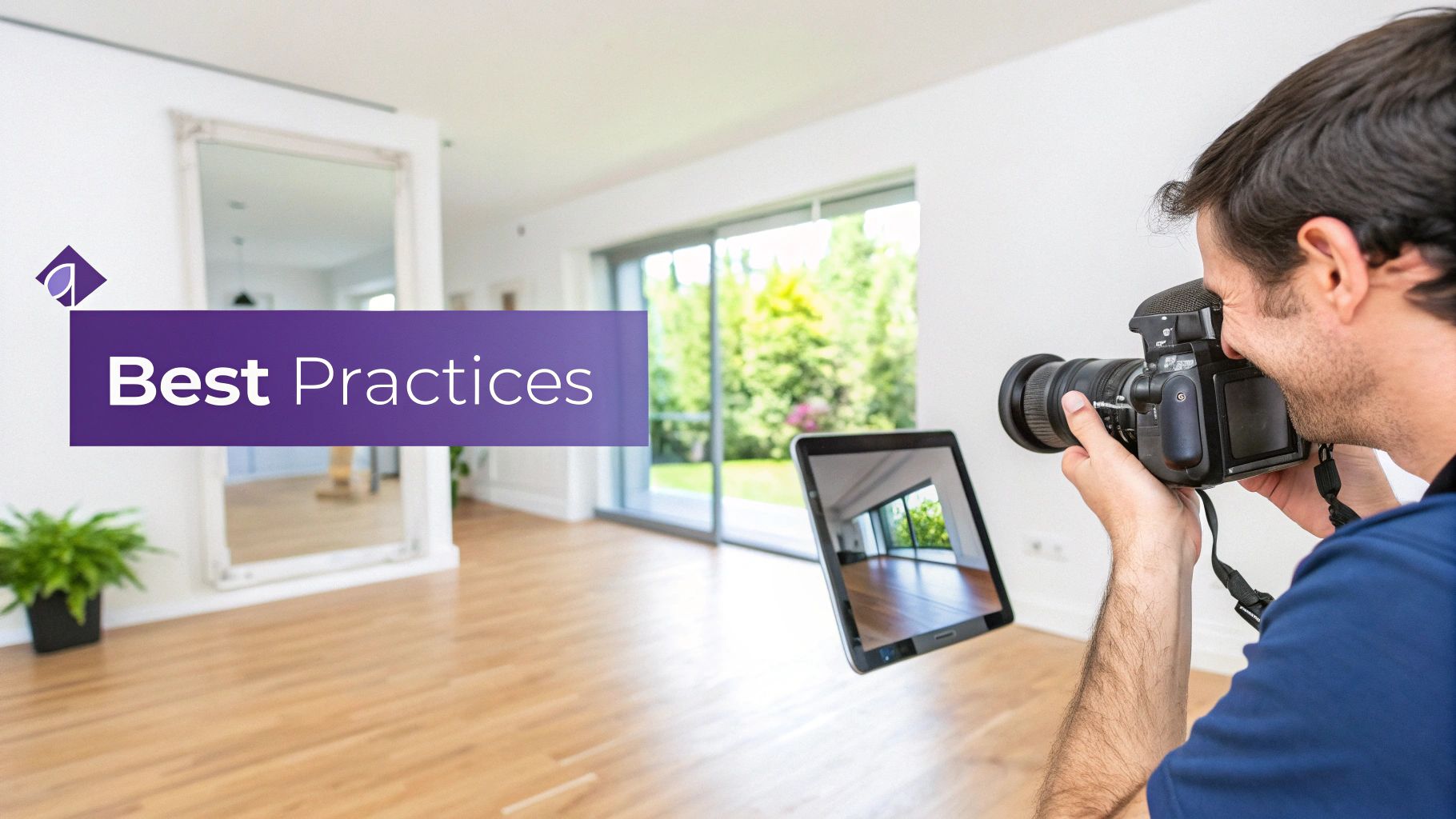
Simply having access to real estate virtual staging software isn't a magic wand for amazing results. It's how you use it that counts. To create visuals that truly connect with buyers, you need a smart approach that starts well before you even open the app.
Think of it like cooking: the best chef can't make a great meal with bad ingredients. The same goes for virtual staging. The foundation for every stunning result is a high-quality photograph. Your images need to be crisp, well-lit, and shot from a good angle. A blurry photo with weird shadows will make even the best digital furniture look fake, so take the time to get the photography right from the start.
Align Your Design with the Target Buyer
Once your photos are ready, it's time for the fun part: the design. But don't just start dropping in random couches and tables. The key is to match the virtual decor to both the home's style and the likely buyer.
A generic, one-size-fits-all approach rarely works. You need to create a specific vibe.
- Selling a historic home? Try a "Transitional" or even a "Grandmillennial" style. These blend classic and modern touches for a look that feels both timeless and fresh.
- Listing a sleek downtown condo? Go for a Mid-Century Modern or Industrial aesthetic to play up its urban cool factor.
This is where the right tool makes all the difference. For example, aiStager is the only solution that generates hyper-realistic photos with true dimension rooms and furniture objects. It lets you experiment with different looks until you nail the perfect one. You could try out a plush velvet sofa from Joybird and, if it doesn't feel quite right, swap it for a modern leather sectional from Article in a completely different color. That’s the kind of flexibility that lets you perfect your vision.
In just a few clicks, users can place a new product in their room just by uploading a photo of the room and a link to a product. This makes testing different brands, colors, and finishes simple and effective.
Maintain Consistency and Transparency
As you work through the property, keep a consistent design theme from room to room. A cohesive look helps tell a compelling story and makes the home feel thoughtfully put together. And remember, less is more. The goal is to define the space and show its potential, not to cram it full of digital clutter.
Finally, and this is crucial, always be upfront. Make it crystal clear in your listing description that the photos are virtually staged. This builds trust with potential buyers and manages their expectations, ensuring there are no surprises when they see the home in person. Following these simple rules will help you use real estate virtual staging software to create visuals that don't just look good—they get results.
Got Questions? We've Got Answers
Stepping into the world of real estate virtual staging software often brings up a few questions. Let's tackle some of the most common ones to help you get the most out of this powerful marketing tool.
Is Virtual Staging Misleading to Buyers?
That's a fair question, and one we hear a lot. The short answer is no, as long as you're transparent about it. It’s all about proper disclosure.
Most real estate boards and MLS services have a simple rule: just add a clear label like "virtually staged" to any edited photo. The goal isn't to trick anyone, but to help buyers see what an empty room could look like. Think of it as painting a picture of a home's potential.
Good virtual staging never changes a room's actual layout, size, or permanent features like floors and windows. It's simply about adding digital furniture and decor to an otherwise empty canvas.
What's the Investment for Virtual Staging Software?
The cost can swing quite a bit depending on how you approach it. Traditional services often charge per photo, with prices ranging from $20 to over $100 per image. The final price usually depends on how complex the staging is and how quickly you need it done.
A newer, often more budget-friendly option is a subscription-based AI platform. For a flat monthly fee, you get a certain number of "stages," which is a fantastic deal for busy agents or brokerages juggling multiple listings.
Can I Virtually Stage a Room That Isn't Empty?
Absolutely! This is where modern software really shines. Many of the best tools offer a feature called "item removal" or "virtual decluttering." It lets you digitally remove existing furniture from a photo before adding the new, staged pieces.
This is a game-changer for occupied homes. If the seller's decor is a bit too personal or dated, you can showcase a fresh, neutral vision of the space that appeals to a much wider audience.
One of the biggest leaps forward with modern platforms is the ability to use real-world products. For instance, aiStager is the only tool that can create hyper-realistic images using true-to-scale furniture, letting you see exactly how different brands would look in a specific room.
Imagine showing a client how a sleek sofa from Article gives the living room a modern edge, then swapping it out for a cozy sectional from Joybird to create a totally different, family-friendly vibe. With aiStager, all it takes is a room photo and a product link to make that happen in seconds, offering incredible realism and design flexibility.
Ready to turn your empty listings into stunningly furnished homes that grab a buyer's eye? With aiStager, you can create hyper-realistic, dimensionally accurate visuals in just a few clicks. Try aiStager for free and see the difference.